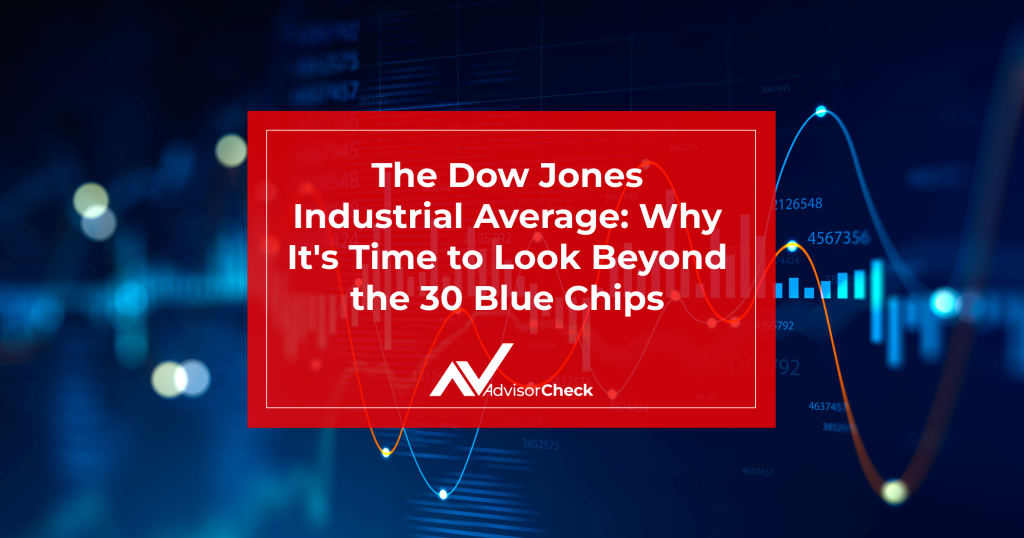
The Market
The Dow Jones Industrial Average: Why It's Time to Look Beyond the 30 Blue Chips
We are in the spotlight












Are you looking for a better way to stay informed about the stock market? The Dow Jones Industrial Average (DJIA) is frequently used as an indicator of America's entire stock market, but many investors have become weary that it fails to accurately measure the overall performance and trends of the market. And they're right—this 30-stock index does not reflect what's really happening across the U.S. economy and global markets, so it's about time we look beyond the traditional blue chip stocks for our investment guidance. The Dow Jones Industrial Average (DJIA) is a US stock market index that tracks the performance of 30 large publicly-owned companies. It's also one of the most widely watched and influential stock market indexes in the world, despite only being comprised of 30 large, blue-chip companies listed on the New York Stock Exchange and NASDAQ. This index is often used as an essential barometer for the US economy and is widely tracked and referenced in the financial media. And while it may not be a perfect reflection of the entire stock market, it is still highly regarded and has been used as a benchmark for over a century. In addition, the companies that make up the DJIA are relatively diverse and come from various industries, such as Apple in technology, Coca-Cola in consumer goods, and JP Morgan Chase in financial services. First established by Charles Dow in 1896, the DJIA was created to measure the daily performance of the largest US companies. Initially, the index consisted of just 12 companies representing sectors such as sugar, tobacco, oil, and railroads. However, the index gradually grew over time and expanded to its current structure of 30 large-cap USA-based companies by 1928. These companies are included based on various criteria such as size, liquidity, and industry group representation. Over time, companies are cycled in and out of the index based on specific criteria such as market capitalization, liquidity, and industry performance. Companies with higher market capitalization or liquidity are often given priority when making changes to the DJIA index. Their industry performance is also considered before any induction or removal from the index. Ultimately, these changes aim to maintain the relevance of the index as it hopes to reflect current trends in the stock market. In general, inductions to the index can often positively impact the company and the DJIA overall, while removals can hurt its performance. For example, in 2020, shares of Salesforce, Amgen, and Honeywell all went up around 3 to 4% shortly after being added to the Dow, while shares of Exxon, Pfizer, and Raytheon were all down about 2% after being dropped. This shows how simply being added or removed from the index can impact a company’s stock price, regardless of the earnings or fundamentals of the business. But despite being such a widely used indicator, there have been many instances in which DJIA has been criticized due to its limited selection of stocks which tend to reflect only a tiny segment of investments and does not necessarily reflect all economic conditions accurately. In a recent article on Yahoo News, Allan Sloan, a business writer with over 50 years of experience and a seven-time winner of business journalism's highest honor, the Gerald Loeb Award, wrote in criticism of the Dow: "But I do know that although the Dow is a sort of outdated relic, it’s hard to resist writing about it. After all, it’s the market indicator we’ve all grown up hearing about. So listen to the Dow news all you like—just don’t care about it. And don’t let it influence your investment decisions."What Is The Dow Jones Industrial Average (DJIA)?

A Brief History Of The 30 Blue Chips That Make Up The Dow Jones Index.

Finance behemoths like Bloomberg and the Wall Street Journal make you pay to learn about finance. We share our insights to expand your financial literacy for free.
While the Dow Jones Industrial Average (DJIA) has been a cornerstone of the financial industry for over a century—times are changing. Many experts like Sloan are beginning to question its relevance in today's rapidly evolving economy. And increasingly, investors are turning to alternative indexes to gain a more accurate picture of the current financial landscape. So while the DJIA will likely remain popular for years to come, it's clear that other metrics are better suited to the increasingly complex world of finance. One of the major problems with the DJIA is that while it only contains 30 large companies, the entire US stock market is made up of roughly 4,000 different publicly traded companies. This means that if one of the 30 companies in the DJIA has a significant increase or decrease in value, that can significantly impact the Dow, even if it has a minor impact on the overall stock market. In addition, with just 30 companies, the Dow does not paint an accurate picture of the US stock market by sector. For example, the top 3 sectors in the Dow Jones are Healthcare (20.47%), Financials (19.86%), and Information Technology (16.93%). Alternatively, the S&P 500, which includes the 500 largest US companies and is considered to be a more accurate representation of the total stock market, is broken down by the following top 3 sectors: Information Technology (25.73%), Healthcare (14.67%), and Financials (12.84%). So overall, the Dow is more heavily weighted toward Healthcare and Financials, but the overall market is dominated by Information Technology. This is another reason why many feel the DJIA is outdated and inaccurate. “While the Dow Jones Industrial was seen as a source of truth at inception in 1896, it makes less sense in today’s more sophisticated economy,” says Dan Hattori of AdvisorCheck. “A better indicator to look at for the performance of the stock market would be the S&P 500,” Dan continued. As investors and traders seek more comprehensive approaches to measuring stock performance, alternatives to the Dow Jones Industrial Average (DJIA) have emerged. Critics argue that the DJIA is outdated and does not accurately reflect the diversity of the current market. As a result, alternatives such as the S&P 500, which tracks 500 large-cap stocks, and the NASDAQ Composite, which includes more than 3,000 companies, have gained popularity. Diversification is critical in investing, and these alternative indexes offer a more comprehensive view of the overall market. In addition, most qualified financial advisors prefer to use more diversified and broad indexes when tracking overall stock market performance with their clients. That's because they want to paint a more accurate overall picture of the returns and volatility their clients can expect from their investments. The S&P 500 index is a basket of 500 of the largest publicly-traded companies in the United States, and it aims to track their performance to provide an overall measure of the health of the US economy. This index is a commonly used benchmark to gauge the overall performance of the US stock market, and it covers a wide range of industries. But what makes the S&P 500 so attractive? One of its key features is its diversification, which spreads risk across multiple sectors and helps mitigate the impact of any single company's poor performance. Additionally, the S&P 500 has a strong track record of growth over the long term, averaging an annual return of 10% since its inception in 1957. And even Warren Buffet, one of the greatest investors of all time, loves the S&P 500 and has said: “In my view, for most people, the best thing to do is own the S&P 500 index fund.” But, before you go all in on the S&P 500, it may be wise to find a trusted financial advisor who can help you develop a custom portfolio specially tailored to your investment needs.Why Many Industry Experts Are Beginning To Look Beyond The Dow For More Accurate Information.

Understanding Alternatives To The DJIA For Tracking The Stock Market.

Here Are Some Of The Top Alternatives To The Outdated DJIA:

Alternative #1: The S&P 500 Index

What is the S&P 500 Index?
Few people are aware that financial advisors help you with more than investments, but help you find HUGE tax breaks that could help you achieve your financial goals at a MUCH quicker rate.
Use AdvisorCheck to find the best financial advisors near you.
The Nasdaq Composite is an index of more than 3,000 stocks traded on the Nasdaq stock exchange, which provides a benchmark for gauging the performance of technology and growth stocks. If you're interested in tracking the performance of technology companies, then the Nasdaq composite is the index to watch. This market index is made up of more than 3,000 companies, including big names like Apple, Amazon, and Microsoft. Unlike the Dow Jones and S&P 500, the Nasdaq is heavily weighted towards the technology sector, making it a valuable indicator of the overall health of this industry. The Nasdaq has seen significant growth in recent years as technology has become an increasingly important part of our lives. Keeping tabs on this index is a great way to stay informed about the latest trends and developments in the tech world. The Wilshire 5000 Total Market Index is a comprehensive measure of the US stock market, made up of over 3,500 individual stocks that represent the performance of publicly traded companies in the US. It's a mouthful, but it's also a great way to track the performance of the entire U.S. stock market. This index includes roughly 3,500 stocks from all sectors and market capitalizations, giving investors a comprehensive view of the market as a whole. The name might suggest that it encompasses 5,000 stocks, but that was its original goal back in the 1970s. Despite falling shy of that number, the Wilshire 5000 has become a popular benchmark for many investors due to its broad diversification and market coverage. So, if you're looking for a simple yet effective way to track the health of the U.S. stock market, the Wilshire 5000 Total Market Index is worth considering. With the ever-evolving financial market and the rise of new industries and technologies, it's time to expand our perspective beyond just the Dow. While the Dow Jones Industrial Average has been a reliable barometer for stock prices for over a century, it only represents 30 companies out of the thousands currently traded on the stock market. By only looking at the Dow, we're missing valuable insights into other sectors, such as technology and renewable energy. It's essential to shift our focus to other indicators like the S&P 500, the NASDAQ, and the Wilshire 5000, which cover a broader range of companies and provide a more accurate view of market performance. By adopting a more comprehensive approach to evaluating stock performance, we can make more informed investment decisions and capitalize on new opportunities in the market. Are you looking for the right financial advisor to help you start investing but feeling overwhelmed by the choices? Let AdvisorCheck help you find the perfect match! Our free membership makes it easy for you to find a reputable and certified financial advisor who meets all your needs. Our platform offers a wide range of experts in various areas of finance, so you can rest assured knowing that you'll be well taken care of. Signing up is simple and hassle-free - just take a few minutes to join us today and start discovering your ideal financial advisor! With our platform, you can ensure your finances are in the best hands possible. So what are you waiting for? Join AdvisorCheck now and make the smart move toward achieving your financial goals! Written by Anders Skagerberg, CFP Fact checked by Billy Quirk Reviewed by KJ KimAlternative #2: The Nasdaq Composite

What is the Nasdaq Composite?
Alternative #3: The Wilshire 5000 Total Market Index

What is the Wilshire 5000 Total Market Index?
It's Time To Move Beyond The Dow.

Your go-to source for:
- Breaking out from living paycheck to paycheck
- Countering inflation with saving hacks
- Saving for your or your kid’s futures
- Turning home ownership from a dream into a reality
Disclosure The information provided in this article was written by the research and analysis team at AdvisorCheck.com to help all consumers in their financial journeys, by providing the resources and the insights to help improve one’s financial health, make it through recessionary and inflationary periods of time, and save their earnings to use them towards building a secure financial future. Unauthorized reproduction or use of this material is strictly prohibited without prior approval. Any parties interested in content syndication, references, interviews, or PR, please contact our marketing team at marketing@aimranalytics.com AdvisorCheck.com is an independent data and analytics company founded on the principles of helping to provide transparency, simplicity, and conflict-free information to all consumers. As an independent company providing conflict-free information, Advisorcheck.com does not participate, engage with, or receive funding from any affiliate marketing programs or services. To become a free AdvisorCheck member, visit advisorcheck.com/signup
Most read
The content of video and blog articles are for informational and entertainment purposes only and do not constitute investment, tax, legal, or financial advice. Always consult with a qualified professional before making any financial decisions. The views expressed are those of the author and do not reflect the opinions or recommendations of any affiliated entities.
